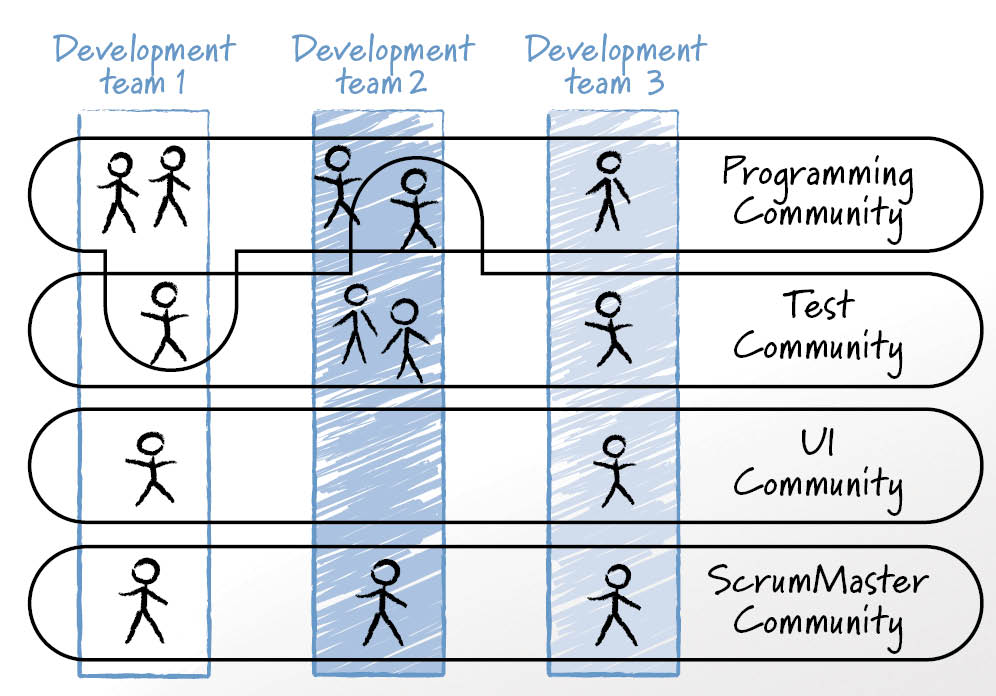On a multi-team project, it is possible for individuals to become isolated, speaking mostly to others on their individual teams. Good ideas are slow to propagate across the organization. Similar functionality is implemented differently by different teams. We put scrum of scrums meetings in place to reduce the impact of some of these problems, but those only go so far. An additional solution and one that is critical to the success of any large Scrum project is the cultivation of communities of practice. A community of practice is a like-minded or like-skilled group of individuals who voluntarily come together because of their passion and commitment around a technology, approach, or vision. On a large project, these communities of practice are helpful for cutting across the boundaries of and pulling together individuals from the many cross functional teams. An example can be seen in the figure below.

The figure above shows communities of practice formed simply around various project roles. In addition, a sufficiently large project might have communities of practice form around technologies (a Ruby community and a .NET community, for example), around interests (mock objects, artificial intelligence, test automation), or around any thread of common interest to multiple development teams. A good example of a community of practice is the Virtual Architecture Team at Salesforce.com, as described by Eric Babinet and Rajani Ramanathan.
The Virtual Architecture Team (VAT) is “virtual” as it is made up of developers from every Scrum team. Members work on the VAT in addition to being on a Scrum team. The VAT owns maintaining and extending our industry-leading software architecture. They do this by defining the architectural road map, by reviewing architecturally significant changes to the code, and by defining standards to ensure consistent and maintainable code.
Communities of practice can span more than one project. For example, a community of practice around test automation may form and include members from multiple, completely unrelated projects. Because they span teams, communities of practice are a primary mechanism for spreading good ideas among teams and for ensuring desirable levels of consistency or commonality across a set of development teams. A community of middle-tier programmers might, for example, discuss and decide when would be the best time to upgrade to the latest version of application server software for a family of products. Discussions among members of an orthogonal test team would ensure consistent test tool usage and the sharing of good practices.
The most effective type of community of practice within Scrum organizations seems to be one that forms organically rather than by management request, although both approaches can be used for different purposes. Because self-organization is critical to successful agile teamwork, the formation of self-organizing communities of practice creates a powerful synergy. In this sense it is up to the organization and its leadership to create an environment in which communities of practice can form, flourish, and then fade away as they run their course.
If you want communities of practice to form organically, you may need to provide some encouragement. Potential community members will need to know that it is OK—and in fact encouraged—for them to form communities. I’ve encountered a few situations where managers and executives gave their Scrum teams a great deal of leeway in self-organizing and were left wondering why no communities of practice formed. When I asked the team members about this, they told me they were under the impression that such informal groups would be frowned upon by management. Make sure your team members know that such cross-team communities are not only OK but encouraged.
No matter which agile project management approach you are using, communities of practice are well worth the time and investment. The service they provide in aiding communication and coordination across a large organization or a large project is invaluable. If communities of practice have not yet formed in your organization, start one around a topic that interests you or is causing your organization pain. As that community begins to contribute to the organization, other communities are likely to form as well.
Additional advice on cultivating communities of practice and on specialized communities, such as improvement communities and the enterprise transition community, is provided in Chapters 4 and 17 of Succeeding with Agile.
Last update: December 17th, 2024








